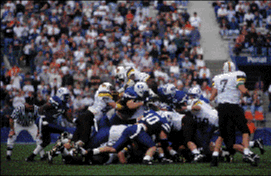Aside from the University of Utah, BYU arguably has no bigger athletic nemesis than the University of Wyoming. Plenty of BYU fans can recall epic Cougar-Cowboy battles in various sports, which over the years have shaped an intense rivalry. One memorable moment occurred in 1981 when BYU football traveled to Wyoming and lost to the ‘Pokes amid a blinding October snowstorm. Coach LaVell Edwards joked afterwards, “I’d rather lose and live in Provo than win and live in Laramie.”
But the last two years have seen a dearth of Wyoming wisecracks. With the expansion of the Western Athletic Conference (WAC) in 1996, rivalries all over the conference were disrupted, and familiar foes rarely crossed each other’s battlefields in season schedules.
This and other problems led to the announcement in May 1998 that BYU, Air Force, Colorado State, New Mexico, UNLV, San Diego State, Utah, and Wyoming plan to break away from the WAC. Their exodus is in search of renewed rivalries, reduced costs, and increased revenues. The group hopes ultimately to create a stronger conference, one that will be better for fans and schools.
As jolting as the announcement was, it shouldn’t have come as a big surprise. The WAC’s decision to add six schools to the existing 10 in 1996 was flawed from the outset. It didn’t take long for post-expansion WAC members to learn that 16 isn’t necessarily sweet and bigger isn’t necessarily better.
The first problem was the busting up of long-standing rivalries. When the WAC expanded, scheduling dictated that BYU take a hiatus from regularly playing Wyoming and other familiar foes like Air Force, Colorado State, and San Diego State. After decades of playing each other, traditional rivals suddenly found themselves competing against unfamiliar teams like Rice, Texas Christian, Tulsa, and San Jose State.
Sixteen proved to be a cumbersome number for scheduling, too. The league devised rotating “quadrants,” which did nothing but confuse everyone from fans to media to coaches to players.
As a result, fan support waned at BYU and other WAC locales. Some BYU season-ticket holders even indicated that the new schedules had something to do with their decisions not to renew their tickets. “They say they don’t know the teams we’re playing anymore,” says BYU advancement vice president Fred Skousen.
In an attempt to resolve rivalry concerns, this spring the athletic directors of WAC schools proposed the league be segregated into two permanent divisions. But there was no consensus as to how the division should be made. The alignment recommended by the majority had Air Force torn from its two biggest rivals, Colorado State and Wyoming, which is akin to splitting up BYU and Utah. Air Force officials were infuriated and publicly threatened to leave the WAC.
“We were all working together to build a conference that was attractive to fans,” says BYU president Merrill J. Bateman. “It had many challenges. For two years we tried to sort out how to play in two divisions and maintain our rivalries. It couldn’t be done.”
Rivalries were not the only thing that needed to be sorted out in the expanded WAC. The 10 school presidents who pulled the trigger on expansion hoped that the conference’s unrivaled size and unusual geographical makeup would attract television and bowl dollars. But the anticipated income did not materialize: post-expansion revenues reached $12 million, about the same amount the WAC was hauling in prior to expansion. Trouble was, revenues in the expanded WAC were divided 16 ways instead of 10.
Exorbitant travel costs also caused trouble. The conference stretches about 4,000 miles from Honolulu to Houston, encompassing nine states and four time zones.
“The financial picture has become paramount in the downfall of the 16-team WAC,” said WAC commissioner Karl Benson on the day the breakup was announced. “We could not generate enough revenue to keep 16 schools satisfied.”
Though the decision to abandon the WAC and sever longtime ties was not an easy one, it was the right one, say BYU officials. “All of us in this conference have been wrestling with these issues for well over a year,” says BYU men’s athletic director Rondo Fehlberg. “We’ve had committees looking at the situation to see if we could create the dynamics it takes to be a successful conference. We weren’t where we needed to be. This is a logical endpoint.”
The new conference is set to begin play in the fall of 1999. With the exception of UNLV, which joined the WAC in 1996, the new, yet-unnamed league looks and smells a lot like the pre-expansion WAC. This impromptu reunion means fierce, old-fashioned rivalries will be restored, and that has struck a responsive chord in fans from Albuquerque to Salt Lake City and from San Diego to Laramie. In that sense the move has already proven successful.
The defectors have begun the arduous process of laying the groundwork for the new conference. An executive committee headed by Colorado State president Al Yates, UNLV president Carol Harter, and President Bateman was formed to oversee the new conference. Doing most of the legwork is a transition team, made up of representatives from the eight schools, including Skousen. “We know there is a lot to be accomplished in the next couple of months,” he says.
A lot indeed. In less than a year, the group must certify the league with the NCAA, lobby to gain bids to championship tournaments, settle on a name, hire a commissioner and staff, establish headquarters, negotiate television contracts, and secure bowl berths. Leaders of the new conference firmly believe the future is bright. “Once we are in place,” Fehlberg says, “I have every reason to believe things will be better.”
The hope for BYU and the seven other departing schools is that they will bid farewell to their recent troubles and say hello again to old friends, a.k.a., foes.
Bring on the Cowpokes.
Jeff Call, a 1994 BYU graduate, is a sports writer for the Deseret News.









